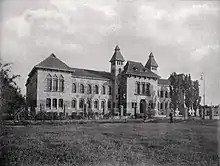Timeline of Poltava
Prior to 20th century
| History of Ukraine |
|---|
.jpg.webp) |
|
|
- 1174 CE - Site "mentioned in the Hypatian Chronicle" as "Ltava."[1][2]
- 1240 - "Destroyed by the Golden Horde."[1]
- 1430 - "Tatar prince Leksada" in power.[2]
- 1569 - Poltava becomes part of the Polish–Lithuanian Commonwealth.[1]
- 1650 - Monastery built.[2]
- 1667 - Poltava becomes part of Russia.[3]
- 1709 - Russian forces defeat Swedish forces near city during the Battle of Poltava.[2]
- 1751 - Construction of Dormition Cathedral begins.
- 1773 - Church of the Resurrection built.[4]
- 1802 - Poltava becomes "a provincial centre."[5]
- 1809 - Column of Victory installed in Alexandrovskaya Square.[4]
- 1818 - Institute for Girls founded.[6]
- 1870
- Poltava-South railway station begins operating.
- Mitnaggedim synagogue built (approximate date).[7]
- 1900 - Population: 53,060.[2]
20th century

Building of the Regional Museum in the early 20th century
- 1901 - Poltava Kyivska railway station begins operating.
- 1902
- 1903 - Poltava Provincial Scientific Archival Commission established.[9]
- 1908 - Zemstvo Building constructed.[4]
- 1913 - Population: 82,100.[10]
- 1924 - Military airfield begins operating.
- 1930 - Poltava Institute of Agricultural Construction founded.[6]
- 1937 - Lokomotyv Stadium built.
- 1939 - Population: 130,305.[3]
- 1941
- 1942
- March: Dulag 205 transit camp for prisoners of war established by the Germans.[12]
- May: Dulag 151 transit camp for POWs established by the Germans.[12]
- June: Dulag 160 transit camp for POWs relocated from Khorol to Poltava.[12]
- June: Dulag 205 camp relocated from Poltava to Krasnohrad.[12]
- December: Stalag 357 prisoner-of-war camp established by the Germans.[13]
- 1943 - German occupation ends.
- 1951 - Urozhai Stadium built.
- 1955 - FC Vorskla Poltava football club formed.
- 1959 - Population: 143,097.[14]
- 1962 - Poltava trolleybus begins operating.
- 1968 - Military school established.
- 1974 - New Poltava Airport terminal built.
- 1975 - Population: 263,000.[15]
- 1985 - Population: 302,000.[16]
- 1992 - Evening Poltava (Вечірня Полтава) newspaper begins publication.
- 2000 - City flag design adopted.
21st century
- 2001 - Population: 317,998.
- 2002 - Kolo (Коло) newspaper begins publication.
- 2006 - Andriy Matkovsky (Матковський Андрій Всеволодович) becomes mayor.[17]
- 2007 - FC Poltava football club formed.
- 2011 - SC Poltava football club formed.
- 2013 - November: Poltava Euromaidan protest begins.
- 2018 - Population: 282,523 (estimate).[18]
See also
- Poltava history
- History of Poltava (in Ukrainian)
- List of mayors of Poltava
References
- Ivan Katchanovski; et al. (2013). "Poltava". Historical Dictionary of Ukraine (2nd ed.). Scarecrow Press. ISBN 978-0-8108-7847-1.
- Britannica 1910.
- Leon E. Seltzer, ed. (1952), "Poltava", Columbia Lippincott Gazetteer of the World, New York: Columbia University Press, p. 1494, OL 6112221M
- Baedeker 1914.
- "Poltava, Ukraine", Britannica.com, retrieved 7 March 2022
- "History", nupp.edu.ua, National University «Yuri Kondratyuk Poltava Polytechnic», retrieved 7 March 2022
- Wiernik 1905.
- Benjamin Vincent (1910), "Russia", Haydn's Dictionary of Dates (25th ed.), London: Ward, Lock & Co., hdl:2027/loc.ark:/13960/t89g6g776 – via Hathi Trust
- "ПОЛТАВСЬКА ВЧЕНА АРХІВНА КОМІСІЯ", Encyclopedia of History of Ukraine (in Ukrainian), Institute of History of Ukraine, archived from the original on 13 March 2022
- "Russia: Principal Towns: European Russia". Statesman's Year-Book. London: Macmillan and Co. 1921. hdl:2027/njp.32101072368440.
- "Gefängnis Poltava". Bundesarchiv.de (in German). Retrieved 10 July 2022.
- "German Dulag Camps". Retrieved 9 August 2022.
- "German Stalag Camps". Retrieved 9 August 2022.
- "Population of capital cities and cities of 100,000 and more inhabitants". Demographic Yearbook 1962. New York: Statistical Office of the United Nations. pp. 315–378.
- United Nations Department of Economic and Social Affairs, Statistical Office (1976). "Population of capital city and cities of 100,000 and more inhabitants". Demographic Yearbook 1975. New York. pp. 253–279.
{{cite book}}: CS1 maint: location missing publisher (link) - United Nations Department of Economic and Social Affairs, Statistical Office (1987). "Population of capital cities and cities of 100,000 and more inhabitants". 1985 Demographic Yearbook. New York. pp. 247–289.
{{cite book}}: CS1 maint: location missing publisher (link) - "Матковський Андрій Всеволодович: Екс-мер Полтави", poltava.pl.ua (in Ukrainian), archived from the original on 10 October 2014
- "Table 8 - Population of capital cities and cities of 100,000 or more inhabitants", Demographic Yearbook – 2020, United Nations
Bibliography
- Peter Wiernik (1905), "Poltava", Jewish Encyclopedia, vol. 10, New York, hdl:2027/osu.32435029752854
{{citation}}: CS1 maint: location missing publisher (link) - Annette M. B. Meakin (1906). Russia, Travels and Studies. London: Hurst and Blackett. p. 265. OCLC 3664651.
Poltava
- "Poltava", Encyclopædia Britannica (11th ed.), New York, 1910, OCLC 14782424 – via Internet Archive
{{citation}}: CS1 maint: location missing publisher (link) - "Poltava". Russia with Teheran, Port Arthur, and Peking. Leipzig: Karl Baedeker. 1914. OCLC 1328163.
Wikimedia Commons has media related to Poltava.
This article is issued from Wikipedia. The text is licensed under Creative Commons - Attribution - Sharealike. Additional terms may apply for the media files.